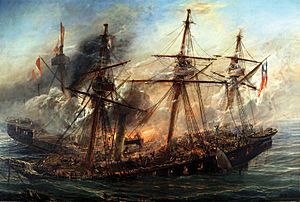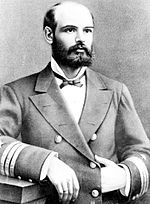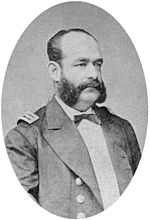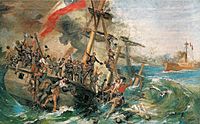Battle of Iquique facts for kids
Quick facts for kids Battle of Iquique |
|||||||
|---|---|---|---|---|---|---|---|
| Part of the War of the Pacific | |||||||
 Sinking of the Esmeralda during the Battle of Iquique, Thomas Somerscales |
|||||||
|
|||||||
| Belligerents | |||||||
| Commanders and leaders | |||||||
| Strength | |||||||
| 1 ironclad | 1 corvette | ||||||
| Casualties and losses | |||||||
| 8 killed and wounded | 143 killed and wounded 57 captured 1 corvette sunk |
||||||
The Battle of Iquique was a major sea battle that happened on May 21, 1879. It was part of the War of the Pacific. In this battle, a Chilean ship called the Esmeralda fought against a powerful Peruvian ship named the Huáscar.
The battle took place near the port of Iquique, which was in Peru at the time. After four hours of fighting, the Chilean wooden ship Esmeralda was sunk by the Peruvian ironclad Huáscar. This meant Peru won the battle.
Contents
Why the Battle Happened
In 1879, there was a big problem over valuable minerals. Bolivia threatened to take over a mining company that had investors from Chile and Britain. Chile responded by sending soldiers to take control of the port of Antofagasta.
This made Bolivia's president, Hilarión Daza, declare war on Chile. Peru had a secret agreement with Bolivia from 1873. Even though Peru tried to find a peaceful solution, Chile knew about the secret pact. So, on April 5, Chile declared war on both Peru and Bolivia.
Both sides knew that controlling the sea was super important to win the war. Chile wanted to destroy the Peruvian Navy first. The main Chilean ships sailed north to attack the Peruvian Navy at Callao.
Meanwhile, two older Chilean wooden ships, the Esmeralda and the Covadonga, were left to block the Peruvian port of Iquique. But two strong Peruvian ironclad ships, the Huáscar and the Independencia, sailed south without being seen. These ships were led by Rear Admiral Miguel Grau.
The Esmeralda, commanded by Captain Arturo Prat, and the Covadonga, led by Captain Carlos Condell, were the only Chilean ships left at Iquique.
The Ships Involved
The Chilean ship Esmeralda was a wooden corvette. It was built in 1854 and had many cannons. It was later updated with stronger cannons.
The Peruvian ship Huáscar was an ironclad. It was built in 1865 and was much heavier and stronger. It had two very powerful cannons, smaller cannons, and even a Gatling gun (an early machine gun). It could also travel at a good speed.
Before the Battle


On the morning of May 21, 1879, a thick fog covered the harbor. Around 6:30 AM, as the fog began to clear, a lookout on the Covadonga spotted smoke. They couldn't tell what ships were coming at first. Soon, they realized it was the Peruvian ships, the Huáscar and the Independencia.
A sailor on the Covadonga used a telescope and confirmed it was the Peruvian squadron. Captain Condell immediately fired a warning shot to alert the Esmeralda.
At the same time, Peruvian Admiral Grau spoke to his crew on the Huáscar. He told them that Iquique was in sight and it was time to fight the enemy. He reminded them of past victories and said, "No matter what the outcome, Peru will not fall. For our fatherland, Long Live Peru!"
Meanwhile, Captain Arturo Prat on the Esmeralda knew they were outnumbered. He ordered his ship to prepare for battle. He then gave a famous speech to his crew:
"Lads, the struggle will be against the odds, but cheer up, and have courage. Never has our flag been hauled down in the face of the enemy, and I hope, thus, this will not be the occasion to do so. For my part, as long as I live, this flag will fly in its place, and if I should die, my officers shall know how to fulfill their duties. Long Live Chile!"
The crews of both Chilean ships got ready for the fight. A bugle sounded, and everyone went to their battle stations.
The battle began when the Huáscar fired its first shot. On land, people woke up to the sound of the cannons and rushed to the beach to watch.
The Battle Begins
At 8:15 AM, the ships started exchanging fire. Captain Prat ordered the Esmeralda to move, and the Covadonga followed. Prat also told a nearby transport ship, the Lamar, to sail away to safety.
A few minutes later, around 8:25 AM, a second shot from the Huáscar hit the Esmeralda. It went through the ship, killing the surgeon and injuring other sailors. Captain Condell on the Covadonga changed course, trying to get behind the Lamar.
Admiral Grau ordered the Independencia to block the Covadonga and Lamar. Prat wondered what Condell was doing, but Condell managed to keep the Covadonga away from the Independencia. The Independencia chased the Covadonga, while the Huáscar focused on the Esmeralda.
Prat moved the Esmeralda very close to the coastline, about 200 meters away. This made it hard for the Huáscar to shoot without hitting the Peruvian town where people were watching. The Peruvian army on the beach also set up cannons to fire at the Chilean ship.
A messenger from the Peruvian army warned the Huáscar that the Esmeralda might have torpedoes. So, Grau stopped the Huáscar about 600 meters away and started firing its big cannons. But the Peruvian sailors were not very good at aiming the Huáscar's main turret, and they missed for about an hour and a half.
The Chilean crew fired back with their smaller cannons and rifles. But their shots just bounced off the Huáscar's strong armor. A grenade from the shore hit the Esmeralda, killing three men. Prat ordered the ship to move again, pushing the engine so hard that one of the boilers exploded.
This made the Esmeralda very slow, moving at only 2 knots (about 3.7 km/h). Grau realized the Esmeralda didn't have torpedoes. A direct hit from the Huáscar killed the bugler and badly hurt the gun crews.
The Huáscar's crew still found it hard to aim because their own town and people were behind the Esmeralda. Missing a shot could hit their own people. Grau decided to end the battle by ramming the Esmeralda.
Heroic Actions and the Sinking
Prat tried to avoid the collision by moving his ship forward. The Huáscar hit near the back of the Esmeralda, but it didn't cause too much damage. After the hit, the Huáscar fired its huge cannons at close range, killing about 40 to 50 Chilean sailors and marines.
In a brave move, Prat tried to jump onto the Peruvian ship. He reportedly shouted, "Let's board, boys!" But only one sailor, Petty Officer Juan de Dios Aldea, followed him because of the loud noise. Prat was shot and killed, and Aldea was badly injured.
As the Esmeralda slowly sank, Grau offered the Chileans a chance to surrender. Lieutenant Luis Uribe Orrego, now in charge, held a quick meeting and decided not to surrender. A sailor climbed the mast to make sure the Chilean flag stayed flying, remembering Prat's words.
Grau then rammed the Esmeralda a second time. Uribe tried to avoid it, but this time the collision made a big hole in the ship. Water rushed into the powder room and engine areas. The Esmeralda had few crew members left and little ammunition.
The Huáscar fired again at close range, causing more deaths. Sublieutenant Ignacio Serrano and eleven other men tried to board the Huáscar like Prat did. But they were met with machine gun fire and were all killed except Serrano, who was badly wounded. Grau ordered Serrano to be rescued and taken to the infirmary.
Twenty minutes later, the Huáscar rammed the Esmeralda a third time. The ship tilted forward and began to sink. As it went down, Midshipman Ernesto Riquelme fired the very last cannon shot. The Chilean flag, still flying from the mast, was the last part of the ship to disappear.
It was 12:10 PM. Grau saw that many Chilean sailors (about 57 survived) were struggling in the water. He ordered his rescue boats to save them. The Chilean sailors were scared at first, but then realized the Peruvians were trying to help them.
Meanwhile, the Independencia was still chasing the Covadonga south of Iquique. The Covadonga stayed close to the shore because the Independencia needed deeper water. But the Independencia hit rocks and got stuck in shallow water.
Captain Condell on the Covadonga then attacked the stranded Independencia, causing it to sink. Most of its crew escaped in lifeboats, but about 20 stayed on board. Condell ordered his men to shoot at the survivors.
Later, Grau learned that the Independencia was being attacked. He quickly went to help. He found the Independencia stuck, with only 20 crew members left. Realizing the ship was completely lost, Grau ordered it to be set on fire after rescuing the remaining crew.
What Happened After
After the battle, Admiral Grau showed great respect. He ordered that Captain Prat's personal items, like his diary, uniform, and sword, be returned to his widow. He also sent her a letter praising Prat's bravery.
News of the battles reached Chile quickly. On May 24, the Chilean Navy held a special meeting. They sent reports to the government. This led to many men joining the Chilean army and navy. They wanted to honor the fallen heroes and help their country win the war.
Peru won the Battle of Iquique. This ended the blockade of Iquique and made Chilean forces pull back for a short time. However, Peru lost the Independencia, one of its strongest warships, in the Battle of Punta Gruesa. Chile, on the other hand, only lost an old wooden ship.
Captain Prat's death became a huge inspiration in Chile. Thousands of young Chileans joined the military. Many historians believe this was a key reason why Chile eventually won the war. Prat became a national hero. Newspapers even started using the word "Pratiotism" instead of "Patriotism."
Since 1905, the date of the battle has been a national holiday in Chile called "Naval Glories Day." Admiral Grau also became a hero. He was known as the "Gentleman of the Seas" for his actions during the battle and his kind gesture to Prat's widow and the rescued Chilean sailors. He is honored in both Peru and Chile.
See also
 In Spanish: Combate naval de Iquique para niños
In Spanish: Combate naval de Iquique para niños
- Battle of Punta Gruesa
- Battle of Angamos
- Arturo Prat


